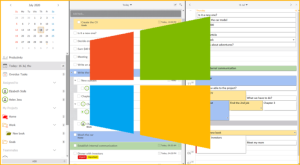How to prioritize: a breakdown of popular methods

Every day we have to do a huge number of things related to work, home, family, and on top of that we want to take time for ourselves and just relax. In such a flow it is difficult to understand what is important and what to do first of all.
By nature, we tend to take the path of least resistance. This means that we tend to push the most complicated, difficult and unpleasant tasks to the back of the schedule and do something easy and fun first. Those dreaded tasks get pushed further away, unfulfilled, and gradually accumulate. Our sense of control begins to wane, our self-esteem drops, and our stress levels rise, resulting in health problems. That is why it is so important to learn to prioritize, as they help to allocate time properly and bring the started tasks to the end.
What is the point of prioritizing

Priority is a key concept of time management, which means priority and importance. At the same time, not only tasks can be prioritized, but also goals, for example, a goal for the year, or a person’s values – work as the main thing in life.
Prioritization is a universal principle that will fit any time management system. It works at all levels of planning, from daily tasks to life values and attitudes. More often than not, people struggle with prioritizing daily tasks. Prioritization helps you understand what to do first and what can wait.
It is important to realize that priorities are set not to do as much work as possible, but to achieve goals without putting in too much effort. Simply put, if you are doing everything in a row, getting very tired, but the result is still not getting closer, you need to rethink your priorities.
It is also worth noting that in such situations, the solution to the problem may not be limited to prioritizing things in the daily schedule. You may need to re-prioritize at a higher level. For example, you have a job that takes up almost all of your time. The question to ask is: Is it worth it? Is it worth the stress and will the effort pay off?
Due to lack of proper rest, your health may deteriorate and you may need medical attention in the future. Evaluate whether you are prioritizing your career and work or your health. If you feel happy now, then your priorities are right.
Do not think that prioritizing is the domain of managers, entrepreneurs and businessmen. Every day each of us has to prioritize, from simple household chores to work issues. The ability to prioritize correctly is a skill that determines personal effectiveness and achievement of key goals.
Benefits of prioritization

Efficient Resource Management. Our resources are strictly limited. As we work, we gradually become tired, slower to think and less motivated. There can’t be more than 24 hours in a day, and some of them are required for rest and sleep. Businesses will always be short of finances, materials, brains and free hands.
If we want to achieve our goals, we need to allocate the right resources. Prioritization allows us to focus our time and efforts on the most important things.
Result-oriented. The tasks to be performed are heterogeneous. Some of them affect your physical, psychological and financial well-being, while others do not affect anything. By paying the most attention to cases from the first category, we will be able to achieve greater results and come to our goals faster. Cleaning your apartment and learning a new lesson of an online course will take a couple of hours, but only one of these tasks will bring you closer to your new position.
Effective schedule management. Drowning in a crazy amount of things to do has become quite normal for modern man. However, our bodies can’t keep up with adapting to new conditions, and we regularly get stressed out by the overwhelming amount of things to do.
Proper prioritization filters incoming tasks, helping to separate the really important ones from those that can be postponed or not done at all. This way, your schedule becomes balanced, your overall stress level decreases, and your productivity increases.
Work-life balance. Have you ever met successful but unhappy people? In many ways, happiness depends on having the right priorities in life. Outstanding results at work and rapid career growth will not make you happy if you dream of building a strong family. Only by focusing on what is really important can we get what we want from life.
Prioritization methods

As mentioned above, there are different levels of prioritization, and therefore methods can be similarly divided into objectives, goals and values. We advise you to adapt the techniques to your needs. Techniques can be combined, individual elements can be combined with each other, or you can create your own individual prioritization system on the basis of several.
Prioritization of goals and values
Priority list
One of the simplest methods that can be used to assess priorities in any area of life. For example, ask yourself the question, “What is the most important thing for me in my work?” and write down everything that comes to mind. The resulting list is your real priorities. Maybe you thought that the most important thing for you is the salary, but in fact you need a flexible schedule and the ability to take time off at any time. This way you can find out what is most important to you in life, relationships, family, etc.
Association map
Take a sheet of paper and write the word “life” in the center, next to it draw some blocks and write in them the associations that first come to mind and connect them with the word “life”.
Don’t think about the wording. They can be just nouns, verbs, word combinations or whole sentences. Then near each block, draw a few more and write down the associations associated with them. Continue as long as new associations arise.
You can add different levels of connection between goals by using dotted lines, colors, etc. In order to buy a new apartment, you need to find a good job, and this requires getting a sought-after specialty. The most important goal will be the one on which the others are most dependent.
Balance wheel
The Balance Wheel not only helps you prioritize your priorities, but also helps you identify areas of your life that you need to work on to achieve inner balance. At the same time, the wheel can be easily adapted to the business. Instead of your life, you can analyze sales, management, marketing, HR and corporate culture.
Each direction is a different spoke on the wheel, which is given a score from 1 to 10. If some directions are rated lower, there is an imbalance. This is a signal that it is necessary to pull up the lagging directions in order to restore harmony.
Life assessment
This approach is often practiced in psychology. You write out a list of the main areas of your life or what you consider important. For example, family, health, career, friends, hobbies, finances, spirituality. Opposite each one put a number from 1 to 10, where 1 – not satisfied at all, and 10 – fully satisfied. Ideally, you should get the same values, which indicates balance. If some spheres fall out, it is necessary to correct it.
To do this, set several tasks related to the sagging area. Think about which area makes you sacrifice others and why it happens. For example, let’s take the following situation: a man of 50 has to work overtime to the detriment of his health. He is not interested in building a career, and he works a lot because he is helping his adult children. To restore the balance, we need to figure out what makes him continue to support his children.
Prioritization of tasks
To prioritize tasks, you need to write them down somewhere. This can be a notebook, calendar, electronic agenda or task manager. Be sure to write down all the things that need to be done – both personal and work. Let’s say you have 15 things to do on your list. Now it is important to highlight those that are of value and those that can be postponed or removed without harming your life.
Eisenhower matrix
The matrix proposes to categorize tasks according to the criteria of importance and urgency. It is represented by four squares:
- important and urgent;
- important and non-urgent;
- unimportant and urgent;
- unimportant and non-urgent.
Important tasks with burning deadlines are sent to the first box. Tasks from the third box can be delegated, and those from the fourth box need to be evaluated and filtered once again. Some of them can be safely removed. Special attention is paid to important and non-urgent tasks, as they pose the greatest danger.
It may seem that since they are not urgent, they can wait, but this is where the main nuance lies. The closer the deadline is, the more tasks from the second square will fall into the first. Over time, a huge list will form, which will be impossible to cope with without exertion.
The highest priority is given to the tasks from the first square, the lowest – to the fourth. The priority of the second square is higher than that of the third, but the difference between the tasks is determined not by the order of execution, but by their time consumption. The tasks in the second box should take more time.
ABCDE
Tasks should be divided into five groups, assigning a letter label to each group:
- Tasks A are the most important. These are the critical things that most affect your life. If you don’t do them, you will lose your job, your money, your family. They may be unpleasant, but they must be done.
- Tasks B – have lesser consequences. These tasks should be abandoned in some situations. For example, if you have task A, it is not worth wasting time, proceed to its fulfillment. If there are no such cases or for some reason cannot be done now, proceed to task B.
- Tasks C – have no consequences. They do not affect your life in any way, but it would be good to perform them. For example, call your family or meet with friends.
- Tasks D – can be delegated. It is painless to delegate to someone else to free up more time for tasks A.
- Tasks E – should be removed. Gaming, watching YouTube, and other distractions that you shouldn’t waste time on when you have important things to do.
If there are too many A and B tasks, they are additionally numbered by importance.
Method 1 – 3 – 5
A great method for organizing the day’s to-do’s. You should plan one important task, three tasks of medium importance and five tasks that are the least important but still necessary. In this order, they are done step by step – first the most important, then the three tasks of lesser importance and then the remaining five. Level 2 and 3 tasks can be done in any order, but you cannot jump from level to level. If 8 tasks are not enough, you can change the methodology to suit you and add another level or increase the number of things to do.
To-do list
A simple and straightforward prioritization method. A numbered list is made, with the highest priority cases at the beginning and the lowest priority cases at the end. The tasks are performed in order, starting from the first number. Until the current task is completed, you cannot move on to other tasks. The To-do list is suitable for everyday tasks that can be easily prioritized.
In conclusion, here are some tips to help you prioritize your priorities:
- Define your values and goals. Prioritization should not be an end in itself. When sorting tasks, you need to know why and what you are doing it for.
- Use multiple tools. Try each prioritization method and choose the one that suits you best. Combine multiple prioritization methods for the best effect.
- Priorities change. If you feel like life is going wrong, go back and revisit key areas. You may have become fixated and not noticed how your needs have changed.
- 30% prioritize tasks. If all tasks are important, then none of them are important.
- It’s okay to be distracted. We’re not machines to work at maximum productivity 24 by 7, so consider distractions when planning. Be sure to take breaks to relax, take a walk, or socialize with coworkers.



